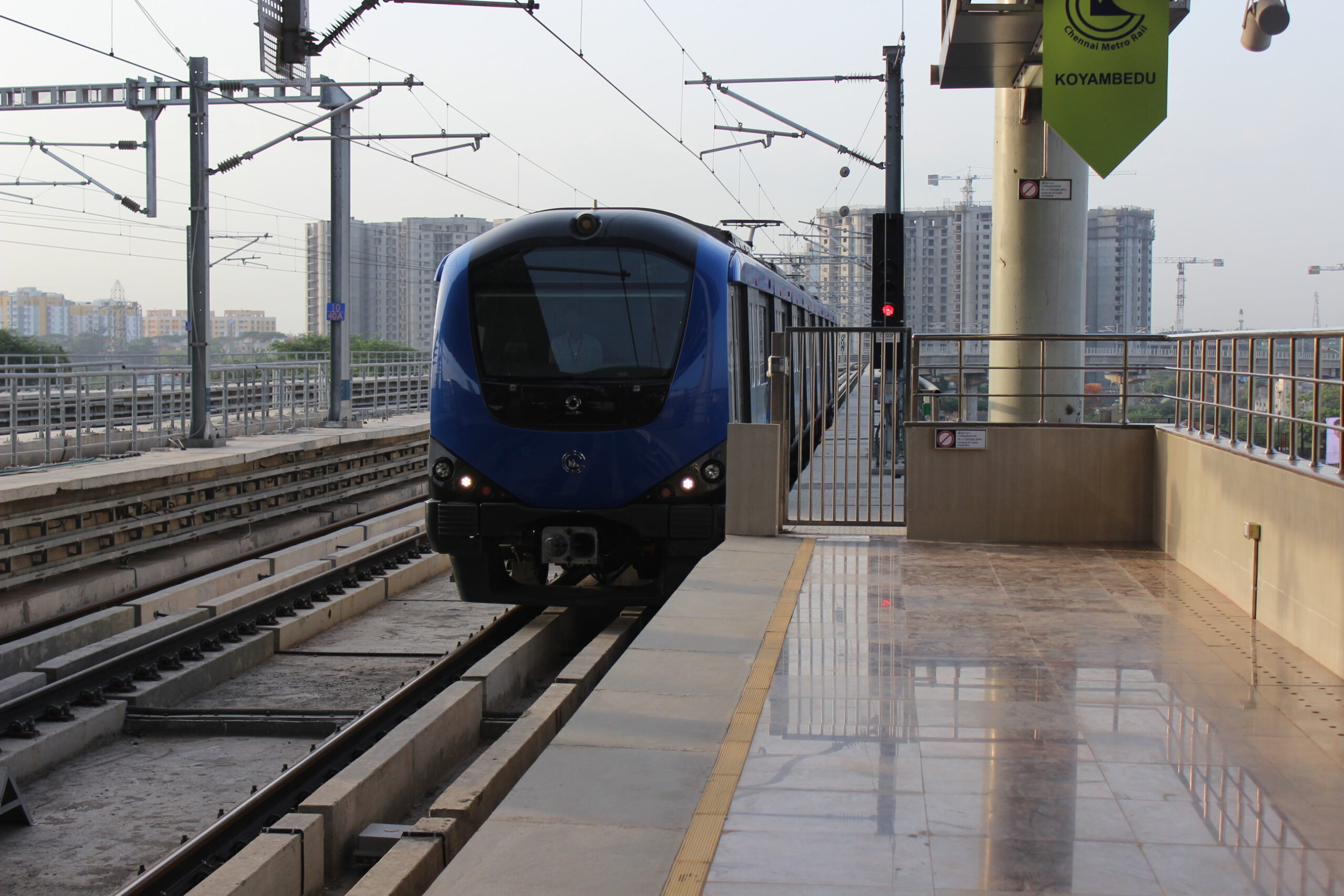Everything You Need to Know about Chennai Metro Rail

Introduction
Chennai, formerly Madras, is the capital of the Indian state of Tamil Nadu (the title held until 1996). The largest city in the state in terms of both area and population is Chennai, which serves as the region’s most important cultural, economic, and educational hub. It is located on the Bay of Bengal’s Coromandel Coast.
Chennai is the fourth-most populous urban agglomeration in India and the sixth-most populous city overall, according to the 2011 census. The Greater Chennai Corporation, the second-oldest city corporation in the world after London and the oldest in India, is the civic body in charge of the city. The Chennai Metropolitan Area, the 36th-largest urban area in the world by population and one of the biggest metropolitan economies in India, comprises the city of Chennai, the Chennai district, and the nearby suburbs.
In the 2014 edition of India Today’s annual survey of Indian cities, Chennai ranked as a beta-level city in the Global Cities Index. It was named the best city in India. The BBC named Chennai the “hottest” city in 2015, citing its blend of traditional and modern values as a reason to go there and stay for a while. The only South Asian city to appear on National Geographic’s 2015 list of the “Top 10 food cities” was Chennai. Lonely Planet ranked Chennai as the ninth most cosmopolitan city in the world. Chennai’s rich musical history was included on the UNESCO Creative Cities Network (UCCN) list in October 2017. The city is home to more than one-third of India’s automobile industry.
Chennai, which houses the Tamil film industry, is a significant hub for filmmaking. In addition, one hundred Indian cities will be transformed into smart cities as part of the Smart Cities Mission.
Chennai is an important center for India’s music, art, and culture. The city is renowned for its performances of classical dance. The Bachelor of Arts program at Madras University included a music course for the first time in India in 1930. Every December, the Madras Music Season, started by the Madras Music Academy in 1927, is observed. It includes traditional Carnatic performances by numerous musicians in and around the city. Gaana, a fusion of various folk kinds of music primarily sung in the working-class neighbourhood of North Chennai, is the primary folk music in the city of Chennai.
Regarding Chennai Metro
The various landmarks that once defined Chennai have given way to traffic jams. The daily commute had turned into a challenge because of the unsettling traffic. As a result, the metro has grown more important over the last ten years. An Indian rapid transit system that serves Chennai, Tamil Nadu, is called the Chennai Metro project. It is India’s fourth-longest metro system, behind Namma Metro, Hyderabad Metro, and Delhi Metro. The system was used in 2015, halfway through the project’s initial phase.
The city’s rapid transit system, Chennai Metro, began operations on June 29, 2015. The Chennai Metro was planned and approved by the state cabinet in 2007, with construction starting in 2009 to enhance the city’s public transportation system and prepare for future commuter needs. [374] The Blue Line and the Green Line, which together make up Phase I of the Chennai Metro network, have a combined length of 45.1 km (28.0 mi) and 40 stations, with Alandur and Chennai Central acting as interchanges. In Phase I, there are 55% underground corridors, and the remaining 25% are elevated.
On June 29, 2015, the first section of Phase I, which spans seven stations over 10 kilometers (6.2 mi) from Koyambedu to Alandur, went into operation. As of March 2019, the entire Phase 1—from Chennai Central to Alandur on the Green Line and Washermanpet to Chennai International Airport on the Blue Line—was fully operational and open for business, bringing the operational network’s total length to over 45 km. This makes Phase I in its entirety functional. Furthermore, subject to approval from the State and Central governments, Chennai Metro Rail Limited (CMRL) announced Phase 2 of Chennai Metro in December 2016, with a length of 104 km and 104 stations.
Construction is scheduled to start in late 2019 or 2020 after Phase 2 was approved in late 2018 with conditions. Soil testing for stations is underway. Following the opening of the entire Phase, ridership has increased and is now at about 100,000 daily commuters. By June 2020, Phase I-A, an extension of the Blue line from Washermanpet to Thiruvottiyur, is anticipated to open.
The CMRL’s Launch
On June 29, 2015, the public could ride the 4.5-kilometer Chennai Metro Rail Limited (CMRL) route between the Alandur and Koyambedu stations. On September 21, 2016, the Chennai Metro began running between the Metro Station at Chennai International Airport and Little Mount.
The Chennai Metro’s Estimated Budget
The estimated cost of the Chennai Metro project is INR 14,600 crores, which includes interest during construction, escalation, and central taxes, but excludes state taxes and the value of undeveloped state government land. Around 40% of the cost is expected to be covered by the federal and state governments, and the remaining 60% is financed by debt issued by the Japan International Cooperation Agency (JICA).
Mass Rapid Transit in Chennai
The Chennai Mass Rapid Transit System, a state-owned division of Indian Railways, operates an elevated metro rail line through Chennai. The Southern Railways operates India’s first elevated railway line, the nation’s longest elevated corridor at 17 km. They are both operated by Southern Railway and part of a more extensive urban rail network, despite not being connected to the Chennai Suburban Railway.
Within the city’s boundaries, a 19.34 km (12.02 mi) line runs from Chennai Beach to Velachery. With average daily traffic of 100,000 people, it has 18 stops. The Mass Rapid Transit System reported revenue of 198.9 million in 2011–2012, an increase of 16.25%. Chennai Metro Rail Limited will take over the Mass Rapid Transit System in the coming years, bringing all elevated and underground routes inside the city under a single organization.
Route Of Chennai Metro
Phase 1 :
Two 45-kilometer-long corridors would be built as part of the Chennai Metro project’s first phase. The metro train network will be elevated for the final 21 kilometers and underground for the first 24 kilometers. The 22-kilometer second corridor of the Chennai Metro will run through Koyambedu from Chennai Central to St. Thomas Mount.
All significant intersections and significant transit hubs in the capital of Tamil Nadu, including Chennai Central, Chennai Egmore, and Central Mofussil Bus Terminal (CMBT), Chennai Airport, St. Thomas Mount, Guindy, Government Estate, and the High Court, are connected under phase 1 of the CMRL projects.
These two corridors were created considering the traffic flow on Chennai’s three main arterial highways, Anna Salai, EVR Periyar Salai, and Jawaharlal Nehru Salai.
Metro station in Chennai: Phase 1 corridor 1
- Washermanpet Metro
- Mannadi
- High Court
- Central Metro
- Government Estate
- LIC
- Thousand Lights
- AG-DMS
- Teynampet
- Nandanam
- Saidapet Metro
- Little Mount
- Guindy Metro
- Alandur
- Nanganallur Road
- Meenambakkam Metro
- Chennai Airport
Extension of Phase 1: A 9.05-kilometer addition to the current Chennai Metro Blue Line network was authorized in 2015 as part of phase one of the extension. Between Sir Thiyagaraya College and Wimco Nagar, the CMRL phase-1 extension will cost INR 3,770 crores and will have eight metro stations.
- Sir Thiyagaraya College
- Tondiarpet
- New Washermenpet
- Tollgate Metro
- Kaladipet Metro
- Thiruvottiyur Theradi
- Thiruvottiyur
- Wimco Nagar
Phase 1 Corridor 2 of the Chennai Metro’s Route and Stations
Chennai Metro Green Line Route and Stations: Phase 1 Corridor 2 The following 17 stations will be located along Chennai Metro Green Line Corridor 2.
- Central Metro
- Egmore Metro
- Nehru Park
- Kilpauk
- Pachaiyappa’s college
- Shenoy Nagar
- Anna Nagar east
- Anna Nagar Tower
- Thirumangalam
- Koyambedu
- CMBT
- Arumbakkam
- Vadapalani
- Ashok Nagar
- Ekkattuthangal
- Alandur
- St Thomas Mount
Chennai Metro Corridor 3 Route
The Madhavaram Milk Colony will serve as the beginning and end points for the CMRL Corridor 3 route.
The following stations are on the route of Chennai Metro Corridor 3.
- Madhavaram Milk Colony
- Thapalpetti
- Murari Hospital
- Moolakadai
- Sembiyam
- Perambur Market
- Perambur Metro
- Ayanavaram
- Otteri
- Pattalam
- Perambur Barracks Road
- Doveton Junction
- Purasawalkam High Road
- Kellys
- KMC
- Chetpet Metro
- Sterling Road Jn
- Nungambakkam
- Gemini
- Thousand Lights
- Royapettah Government Hospital
- Radhakrishnan Salai Jn
- Thirumayilai Metro
- Mandaveli
- Greenways Road Metro
- Adyar Jn
- Adayar Depot
- Indira Nagar
- Thiruvanmiyur Metro
- Tharamani Link Road
- Nehru Nagar
- Kandanchavadi
- Perungudi
- Thoraipakkam
- Mettukuppam
- PTC Colony
- Okkiyampet
- Karapakkam
- Okkiyam Thoraipakkam
- Sholinganallur
- Sathyabama
- St Joseph College
Corridor 4
The CMRL route’s Corridor 4 will have the following 30 stations.
- LightHouse
- Kutchery Road
- Thirumayilai Metro
- Alwarpet
- Bharathidasan Road
- Adyar Gate Junction
- Nandanam
- Natesan Park
- Panagal Park
- Kodambakkam Sub Urban
- Meenakshi College
- Power House
- Vadapalani
- Saligramam
- Avichi School
- Alwarthirunagar
- Valasaravakkam
- Karambakkam
- Alapakkam
- Porur Junction
- Chennai Bypass Crossing
- Ramachandra Hospital
- Iyyappanthangal Bus Depot
- Kattupakkam
- Kumananchavadi
- Karayanchavadi
- Mullai Thottam
- Poonamallee bus terminus
- Poonamalle Bypass
- Poonamallee Bus Depot
CMRL Corridor 5 route and stations
The 18 stations in Corridor 5 of the CMRL will be as follows:
- Madhavaram Milk Colony
- Venugopal Nagar
- Assisi Nagar
- Manjambakkam
- Velmurugan Nagar
- MMBT
- Shastri Nagar
- Retteri
- Kolathur
- Srinivasa Nagar
- Villivakkam Metro
- Villivakkam Bus Terminus
- Nadhamuni
- Anna Nagar Depot
- Tirumangalam
- Kendriya Vidyalaya
- Kaliamman Koil Street
- CMBT
Metro Schedules In Chennai
The Chennai metro has a 5-minute peak-hour headway and a 10-minute non-peak-hour headway, and it operates from 5.30 a.m. to 11 p.m., Monday through Saturday.
The Connectivity Effects of Chennai’s Metro
CRML connectivity: Before the coronavirus outbreak, statistics from the government indicate that the CMRL carried, on average, 1.15 lakh passengers daily, with a train running every five minutes during rush hours. This number has decreased to 65,000 per day since the pandemic. The metro network will connect a sizable portion of Chennai as the CMRL extends to additional city districts in Phase 2.
The locations not currently connected by suburban trains and do not have regular mass public transportation were kept in mind when designing the new CMRL corridors. Many areas, including Old Mahabalipuram Road (OMR) and East Coast Road (ECR), are on the radars of prospective homebuyers due to the affordability factor.
Chennai Metro’s Effect on the Real Estate
Cities that establish a metro network see an increase in demand from buyers, investors, and tenants, as well as a value appreciation for housing markets that are better integrated. This is especially true for suburban housing markets, where there is a much higher chance of profit than in cities with exorbitant real estate costs.
Land values within 500 meters of metro rail and upcoming corridors will increase by 10% to 15% in Chennai. The brokerage firm also thinks there is more demand for office and retail space close to metro stations. Along the 100-foot lane of the CMRL, the cost of commercial and retail leasing increased by 50% to 70%.
Chennai’s real estate hot spots will change with the opening the city’s first metro. Located south of the airport and close by, Alandur is connected to the city’s bus terminal at Koyambedu in the first phase by an elevated liAs a result, The journey will take 20 minutes instead of an hour in a car on a good day.
The following advantages and benefits are provided by the metro:
- An increase in land value easier access to employment
- It is now simpler to get to various locations.
- An improvement in living conditions
- Getting there faster Excellent service, dependability, and availability
- De-congestion
- Output growth and system-wide cost reductions
As a result, the metropolis’s many advantages have positively affected the real estate industry.
The Fare Of Metro In Chennai
In February 2021, the CMRL reduced the maximum metro fare by INR 20, from INR 70 to INR 50. The minimum metro fare, suitable for trips up to 2 kilometers in length, was kept at INR 10, though.
On the Chennai Metro, the new pricing structure would charge INR 20 for a route between 2 and 5 kilometers and INR 30 for a route between 5 and 12 kilometers. Commuters will be charged INR 40 for trips between 12 and 21 kilometers. CMRL commuters will be charged INR 50. There will be a 20% discount for those who purchase tickets using the CMRL smart cards or QR code.
Conclusion
Buyers are attracted to neighborhoods with established metros with no connectivity issues as demand grows. As a result, several residential societies have sprung up, and a sizable population has moved.
Regarding the amount of energy used, the amount of space occupied, and the number of passengers transported, the Metro Rail System has proven to be the most effective. The Chennai Metro reportedly carries more than 12 lakh people each day. It is also convenient to get to your destination on time and without incident.



